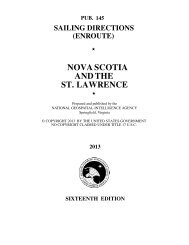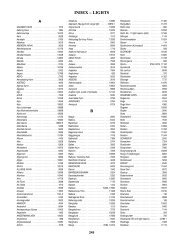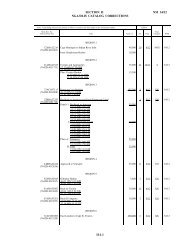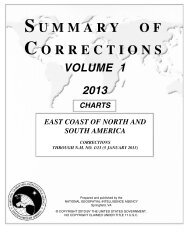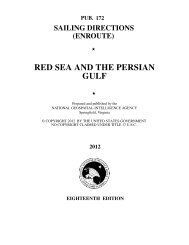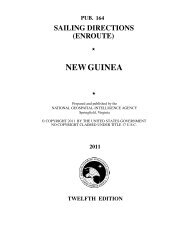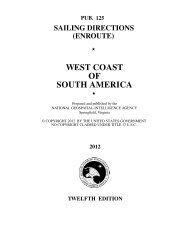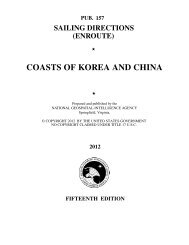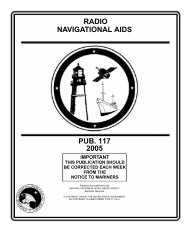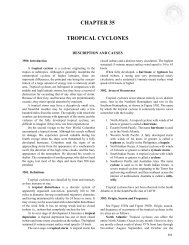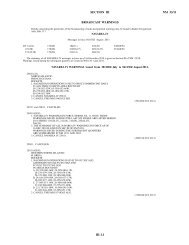LIST OF LIGHTS - Maritime Safety Information - National Geospatial ...
LIST OF LIGHTS - Maritime Safety Information - National Geospatial ...
LIST OF LIGHTS - Maritime Safety Information - National Geospatial ...
Create successful ePaper yourself
Turn your PDF publications into a flip-book with our unique Google optimized e-Paper software.
Lights exhibit a distinctive appearance by which they<br />
are recognized, e.g. Fixed, Flashing, Group Flashing, etc.<br />
The properties of their appearance, by which they are distinguished,<br />
are referred to as the characteristics of the<br />
light. The principal characteristics are generally the<br />
sequence of intervals of light and darkness, and, in some<br />
cases, the sequence of colors of light exhibited.<br />
Fixed lights—those which exhibit a continuous steady<br />
light.<br />
Rhythmic lights—those which exhibit a sequence of<br />
intervals of light and eclipse (repeated at regular intervals)<br />
in a manner described in Chart No. 1 and this volume.<br />
Alternating lights—rhythmic lights which exhibit different<br />
colors during each sequence.<br />
Period of a light—the time occupied by an entire cycle<br />
of intervals of light(s) and eclipse(s).<br />
Range: Meteorological visibility—the greatest distance<br />
at which a black object of suitable dimensions can be seen<br />
and recognized against the horizon sky or, in the case of<br />
night observations, could be seen and recognized if the<br />
general illumination were raised to the normal daylight<br />
level.<br />
Luminous range of a light—the greatest distance at<br />
which a light can be seen merely as a function of its luminous<br />
intensity, the meteorological visibility, and the sensitivity<br />
of the observer’s eyes.<br />
Nominal range of the light—the luminous range of a<br />
light in a homogeneous atmosphere in which the meteorological<br />
visibility is 10 nautical miles.<br />
Geographical range of a light—the greatest distance at<br />
which a light can be seen as a function of the curvature of<br />
the earth, the height of the light source and the height of<br />
the observer.<br />
The visibility of a light is usually the distance that it can<br />
be seen in clear weather and is expressed in nautical miles.<br />
Visibilities listed are values received from foreign sources.<br />
Range lights—two or more lights at different elevations,<br />
so situated to form a range (leading line) when brought<br />
into transit. The light nearest the observer is the front light<br />
and the one farthest from the observer is the rear light.<br />
The front light is normally at a lower elevation than the<br />
rear light.<br />
Directional lights—lights illuminating a sector of very<br />
narrow angle and intended to mark a direction to be followed.<br />
Vertical lights—Two or more lights disposed vertically<br />
or geometrically to form a triangle, square, or other figure.<br />
If the individual lights serve different purposes, those of<br />
lesser importance are called Auxiliary lights.<br />
Occasional lights—lights exhibited only when specially<br />
needed:<br />
NOMENCLATURE <strong>OF</strong> <strong>LIGHTS</strong><br />
XII<br />
(a) Tidal light—shown at the entrance of a harbor, to<br />
indicate tide and tidal current conditions within the harbor.<br />
(b) Fishing light—for the use of fishermen and shown<br />
when required.<br />
(c) Private light—maintained by a private authority<br />
for its own purposes. The mariner should exercise special<br />
caution when using a private light for general navigation.<br />
Seasonal lights—usually shown only during the navigation<br />
season or for a lesser time period within that season.<br />
Articulated lights—offshore aids to navigation consisting<br />
of a length of pipe attached directly to a sinker by<br />
means of a pivot or such other device employing the principle<br />
of the universal joint. The positional integrity is<br />
intermediary between that of a buoy and a fixed aid.<br />
Aeronautical lights—lights of high intensity which may<br />
be the first lights observed at night from vessels approaching<br />
the coast. Those lights situated near the coast are listed<br />
in the List of Lights in order that the navigator may be able<br />
to obtain more information concerning their description.<br />
These lights are not designed or maintained for marine<br />
navigation and they are subject to change without prompt<br />
notification.<br />
These lights are indicated in this List by the designation<br />
AVIATION LIGHT and are placed in geographical<br />
sequence in the body of the text along with lights for surface<br />
navigation.<br />
Aeromarine lights—marine-type lights for which part of<br />
the beam is deflected to an angle of 10 to 15 degrees above<br />
the horizon to facilitate use by aircraft.<br />
Sector limits and arcs of visibility—these are arranged<br />
clockwise and are given from seaward toward the light.<br />
Thus, in the diagram, the sectors of the light are defined<br />
as: obscured from shore to 302°, red to 358°, green to<br />
052°, white to shore. These are bearings of the light as<br />
seen from a vessel crossing the sector lines.<br />
Under some conditions of the atmosphere, white lights<br />
may have a reddish hue. The mariner should not judge<br />
solely by color where there are sectors but should verify<br />
this position by taking a bearing of the light. On either side<br />
of the line of demarcation between white and red there is<br />
always a small sector of uncertain color, as the edges of a<br />
sector of visibility cannot be clearly defined.<br />
When a light is obscured by adjoining land and the arc<br />
of visibility is given, the bearing on which the light disappears<br />
may vary with the distance from which it is<br />
observed. When the light is cut off by a sloping point of<br />
land or hill, the light may be seen over a wider arc by a<br />
ship farther off than by one closer.<br />
Bearings—all bearings are true, measured clockwise<br />
from 000°, and given in degrees or degrees and minutes.



